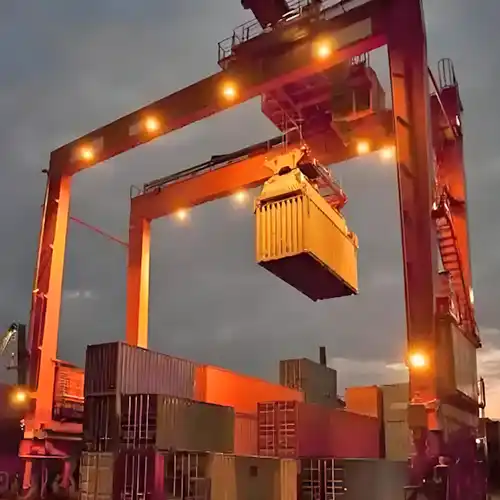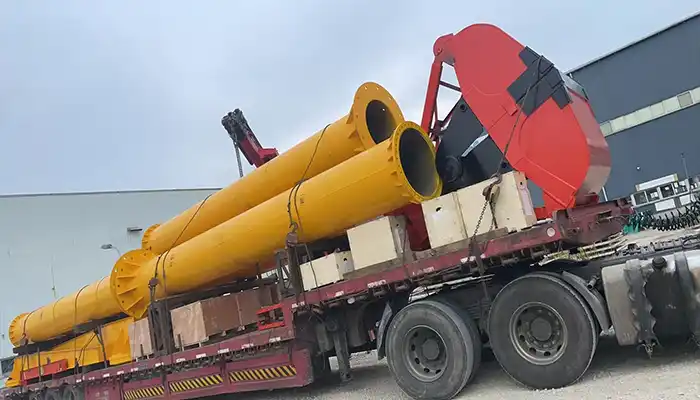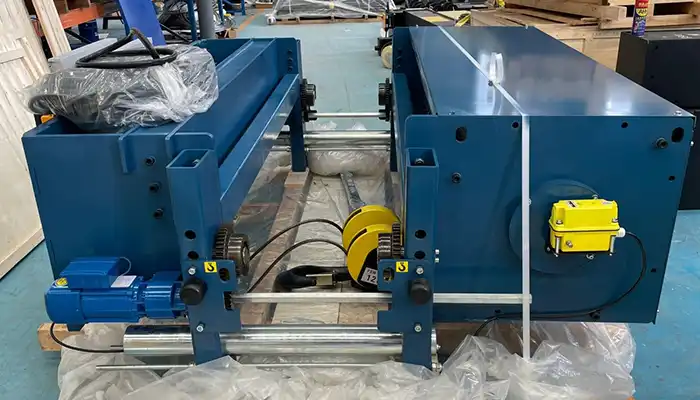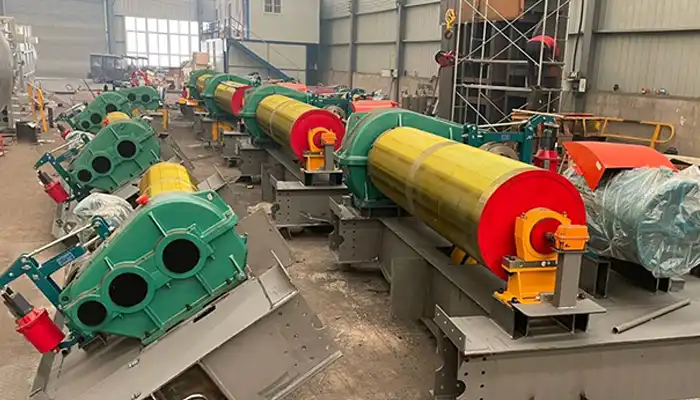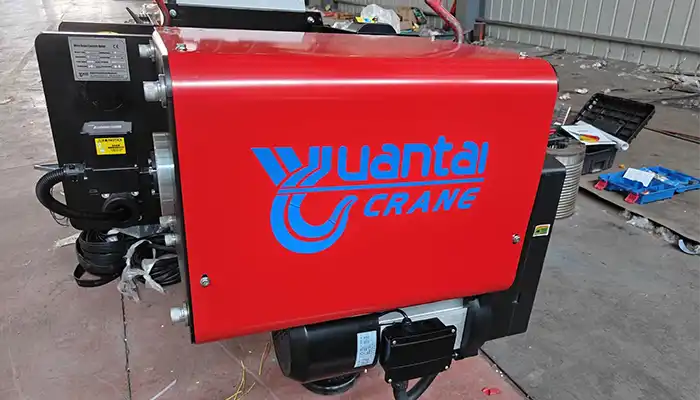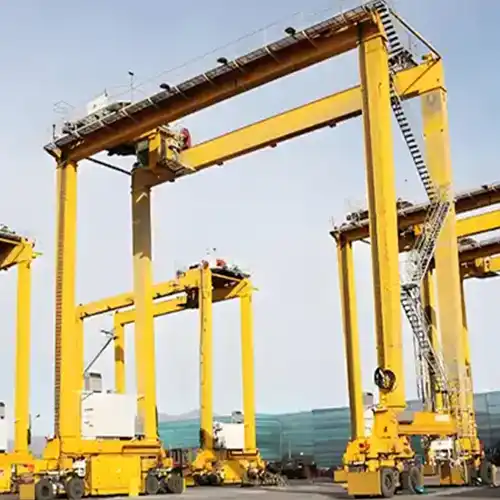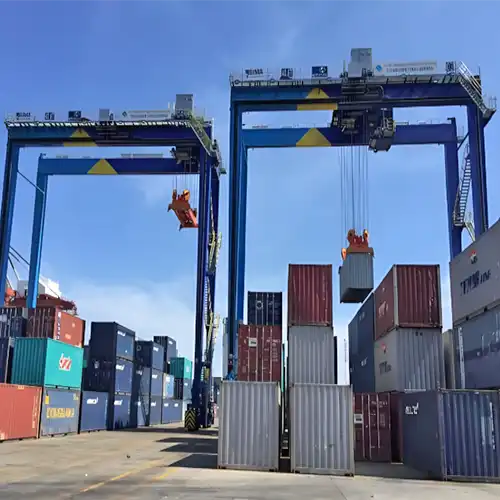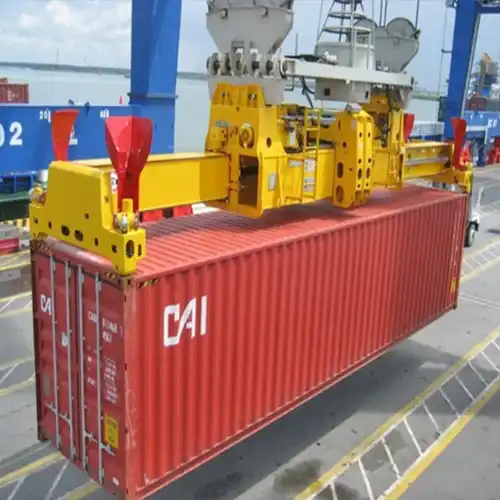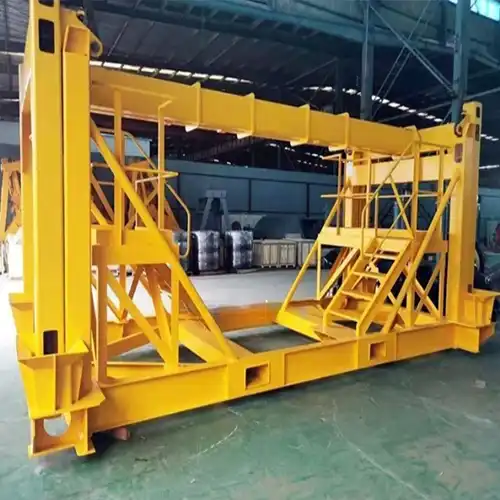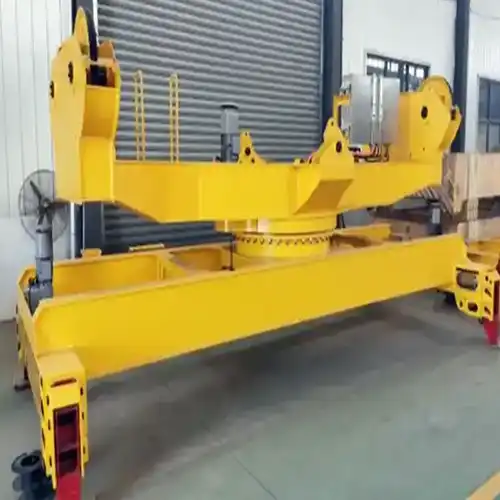Top 5 Container Handling Cranes: Selecting the Best Equipment for Port Operations
Explore the top 5 container handling cranes, their features, capacities, and how to choose the right equipment for efficient port operations.
Category: Featured
Your Trusted Container Handling Crane Manufacturer & Supplier
Top 5 Container Handling Cranes
Choosing the Right Equipment for Your Port Operations
Overview of Container Handling Operations
Container handling is crucial for the smooth operation of ports and terminals. Ports are key points for international trade, and efficient container handling ensures that goods are moved quickly and safely between ships, trucks, and storage areas. Cranes and other handling equipment are essential to making this process work effectively.
- Cranes and handling equipment help optimize storage space.
- They reduce the risk of accidents and increase productivity.
- Without them, container movement would be slow and unsafe.
Ports rely on different types of equipment, including cranes, straddle carriers, and automated systems. These machines work together to load, unload, transport, and store containers, keeping the flow of goods moving smoothly. With growing trade demands, having the right equipment with the proper lifting capacities is crucial to maintaining efficiency.
Role of Cranes, Straddle Carriers, and Other Equipment
- Cranes (e.g., ship-to-shore and gantry cranes) are used to move containers between ships, trucks, and storage areas.
- Straddle Carriers are mobile machines that transport containers short distances within yards. They help manage container stacks, especially in tight spaces.
- Automated Stacking Cranes and Rail-Mounted Gantry Cranes are designed for specific tasks, like stacking containers or moving them between rail and storage areas.
These equipment types work together to make container handling more efficient. They ensure that containers are moved quickly, safely, and accurately within the terminal.
This guide aims to explore the typical crane and equipment capacities used in container handling. It will focus on helping you understand which equipment is best suited for different tasks in port operations.
- We will look at different types of container cranes, straddle carriers, and their lifting capacities.
- You'll learn how these machines are used in terminal operations to increase efficiency and safety.
- By understanding the equipment capacities and their applications, port managers can make better decisions about which machines will work best for their needs.
Types of Container Handling Equipment and Their Capacities
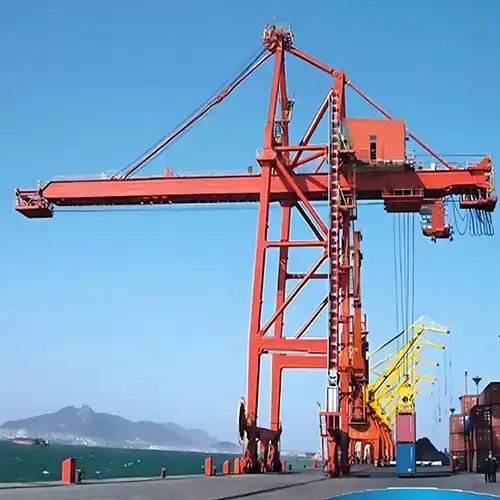
Ship-to-Shore (STS) Cranes
Typical Capacity:40 tons to 100 tons
Applications:
- These cranes are mainly used for unloading and loading containers from ships, including massive ultra-large container vessels (ULCVs).
- They're the backbone of busy container terminals, especially where large vessels come in.
Key Features:
- Large Outreach: STS cranes can extend a long way from the quay, reaching all the way to the hold of large vessels.
- High Lifting Height: With their impressive lifting height, these cranes can easily lift containers from the hold and place them on the quay.
- Customizable for Vessel Size: They're often designed specifically for the size of the vessels they handle, making them a perfect fit for different ports and types of ships.
These cranes are an essential part of modern port operations, capable of handling the heaviest and most complex loads. Thanks to their powerful features, STS cranes make container loading and unloading smooth, fast, and safe.
Rail-Mounted Gantry (RMG) Cranes
Typical Capacity:40 tons to 50 tons
Applications:
- Used primarily for container handling in rail yards, where containers are moved between rail cars and storage areas.
- Crucial for intermodal transport, connecting sea and rail operations seamlessly.
Key Features:
- Rail-Mounted for Stability: RMG cranes are mounted on rails, offering stability during heavy lifting and precise container placement.
- Ideal for Intermodal Transport: Their design makes them perfect for handling containers in rail yards, allowing smooth transitions between different transport modes.
RMG cranes are perfect for busy rail yards, where they ensure containers are efficiently moved and stacked. Their stability and adaptability to intermodal transport make them indispensable for many logistics operations.
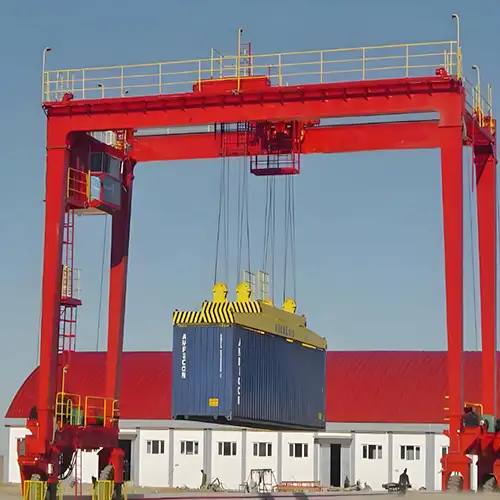

Rubber-Tired Gantry (RTG) Cranes
Typical Capacity:40 tons to 50 tons
Applications:
- Used for stacking containers in yards, particularly in places where space optimization is key.
- Also used for short-distance movements within container yards.
Key Features:
- Mobility for Yard Operations: Unlike rail-mounted cranes, RTGs are equipped with rubber tires, allowing them to move freely within the yard.
- High Efficiency for Stacking and Short-Distance Movement: These cranes excel in container stacking and transporting them short distances, helping optimize yard space.
RTG cranes are known for their flexibility. They're ideal for busy container yards, where quick movements and efficient stacking are necessary to manage high volumes of containers.
Typical Capacity:30 tons to 50 tons
Applications:
- Straddle carriers are primarily used for stacking and transporting containers within the yard or terminal.
- They're particularly useful in operations where containers need to be moved short distances within confined spaces.
Key Features:
- Mobility to Navigate Tight Spaces: Thanks to their compact design and rubber tires, straddle carriers can easily move through narrow aisles and tight yard spaces.
- Ideal for Container Transport Over Short Distances: These carriers are built for quick, short-distance moves, ensuring containers are transferred efficiently between cranes, trucks, and storage areas.
- Versatility in Container Handling: Straddle carriers are incredibly versatile, making them great for various container handling tasks, particularly in busy, high-density yard operations.
Straddle carriers are a valuable addition to container yards, combining mobility and versatility to manage containers efficiently. Their ability to move containers in tight spaces while handling a variety of tasks makes them indispensable in many terminal operations.
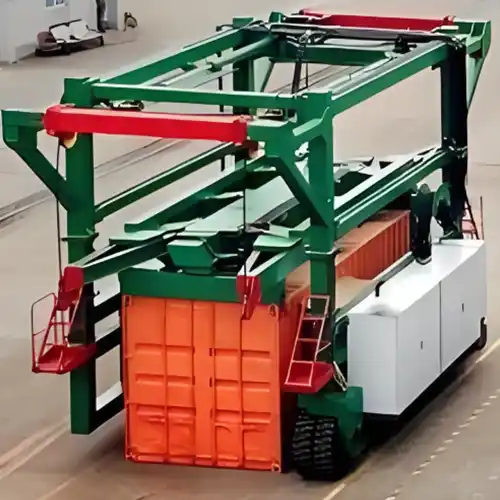
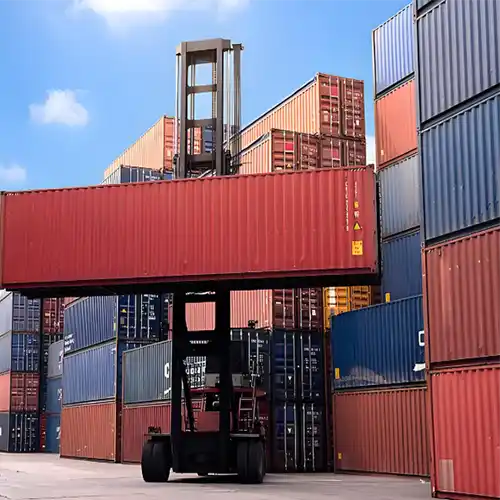
Automated Stacking Cranes (ASC)
Typical Capacity:30 tons to 40 tons
Applications:
- Primarily used in fully automated container terminals for stacking containers in an organized manner.
- These cranes are key players in operations that rely on automation to move containers with minimal human intervention.
Key Features:
- No Human Operators: ASC cranes are fully automated, operating without the need for human control, which increases safety and reduces labor costs.
- High Efficiency and Throughput Rates: These cranes are designed to handle a large volume of containers quickly, making them ideal for high-efficiency, automated terminals.
ASC cranes revolutionize container handling by offering automated precision. Their high throughput and lack of human operators make them perfect for terminals where speed and automation are priorities.
Top-Pick Cranes
Typical Capacity:30 tons to 50 tons
Applications:
- Used for direct container handling from stacks, transferring containers to trucks or ships.
- Ideal for short-term storage and picking up containers for immediate use.
Key Features:
- Versatile for Stacking and Lifting: Top-pick cranes can perform both stacking and lifting operations, making them versatile for various yard tasks.
- Short-Term Storage and Container Pickup: These cranes are excellent for quickly picking up containers and moving them from storage to trucks or ships, reducing waiting times.
Top-pick cranes are valuable for their adaptability. Their ability to quickly stack, lift, and transport containers makes them essential for fast-paced operations that require efficient container handling.
Factors Affecting Crane and Handling Equipment Capacity
Container Size and Weight
The size and weight of containers play a significant role in determining the crane capacity required to handle them efficiently.20-foot Containers & 40-foot Containers
20-foot Containers:
- Empty Weight: Typically around 2.2 to 3.5 tons.
- Fully Loaded Weight: Can reach up to 28 tons.
- These containers are commonly used in international shipping and are the most standard size.
40-foot Containers:
- Empty Weight: Roughly 3.7 tons.
- Fully Loaded Weight: Can go up to 30 tons.
- 40-foot containers are larger, providing more storage but also require cranes with higher lifting capacities.
Reefer Containers:
- Specialized Handling: These are refrigerated containers used for perishable goods, typically heavier due to the cooling system.
- Weight Considerations: The weight can be around 5 to 6 tons empty, and they require power connections for refrigeration during transport.
Specialized Cargo:
- Heavy or Oversized Cargo: Items like machinery, oversized parts, or specialized cargo such as boats or construction equipment often exceed the weight of standard containers, ranging from 30 tons to more than 100 tons.
- Cranes handling such cargo need to be equipped with higher lifting capacities and special features like adjustable lifting slings or heavy-duty hooks.
Ship and Terminal Size
The size of ships and the layout of terminals are critical factors in crane selection, as these influence the reach and lifting power required.
Larger Cranes for Ultra-Large Vessels (ULCVs):
- Ultra-Large Container Vessels (ULCVs) are huge, sometimes carrying up to 20,000 containers. These vessels require much larger cranes with extended reach and the ability to lift heavier loads.
- These vessels' containers are often stacked higher and farther out, demanding cranes with greater outreach (the ability to extend farther from the dock) and higher lifting power.
- Cranes Needed: To serve these vessels, larger Ship-to-Shore (STS) cranes or specialized cranes capable of handling the additional height and reach are used.
Adaptation to Terminal Needs and Layout:
- Smaller Terminals: Smaller terminals handling lower traffic volumes or smaller vessels may use mobile cranes or smaller gantry cranes. These cranes are often designed for high mobility and are suitable for operating in confined spaces or locations with less overall space for crane movement.
- Large Terminals: Large ports handling massive ships require fixed, high-capacity cranes like STS cranes that can provide the needed outreach and lifting height. They are designed for large-scale operations with high efficiency and minimal downtime.
The layout of the terminal, combined with the size and type of ships it services, dictates the selection of cranes that provide the most efficient and safe handling of containers.
Type of Cargo
Cargo type significantly impacts the choice of crane, especially for non-standard goods that require special handling.
Heavy Cargo:
- Items like machinery, large industrial equipment, and oversized parts often exceed the standard weight limit of regular containers.
- Cranes with higher lifting capacities (typically above 50 tons) are required to handle such loads. These cranes also often come with customized lifting gear like spreader bars to ensure safe lifting.
Hazardous Cargo:
- Hazardous materials such as chemicals, explosives, or radioactive substances have additional handling and safety requirements.
- Cranes handling hazardous cargo may need to be equipped with special safety features, such as explosion-proof electrical systems, anti-corrosion coatings, or remote operation systems to minimize operator exposure to danger.
- Some terminals may also require cranes with specialized hooks or lifting devices that ensure safety when handling hazardous materials.
Selecting cranes based on the type of cargo ensures that both handling requirements and safety measures are met, minimizing risks during operations.
Operational Environment
The operational environment, including external factors such as weather and terminal layout, is a major influence on crane performance and capacity.
Wind and Terminal Layout:
- Wind Conditions: High winds can impact crane operations, especially for taller cranes or those handling large, heavy loads. In areas prone to extreme weather, cranes may need to be equipped with wind sensors or designed to withstand gusts and secure loads safely during storms.
- Terminal Space: The layout of the terminal affects which type of crane is most appropriate. Tight, confined spaces may require highly mobile cranes like rubber-tired gantry (RTG) cranes or straddle carriers that can maneuver easily within narrow spaces.
- Large Open Terminals: Larger terminals or ports with vast open spaces might use fixed cranes like STS cranes for their stability and reach, providing ample space for unloading and stacking containers.
Safety Standards:
- Cranes must be designed to meet safety standards that account for the operational environment. For example, in earthquake-prone regions, cranes may need to be built with seismic-resistant features.
- In areas with extreme temperatures or high humidity, cranes might need special coatings or materials to prevent corrosion or wear and tear over time.
- Cranes operating in extreme heat may require insulated controls to protect operators, while cranes working in cold climates may need heating systems to prevent freezing.
By considering the operational environment and ensuring cranes meet the necessary safety standards, terminals can optimize efficiency and ensure the safety of their personnel and equipment.
Why Certain Crane Capacities Are Popular
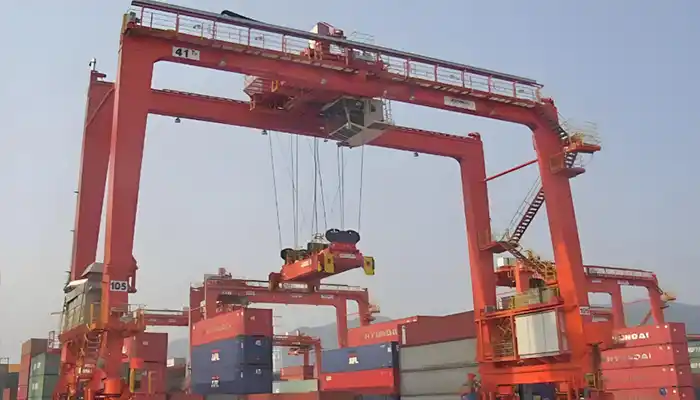
41-Ton Crane Popularity
Ideal for Medium-Sized Terminals:
- The 41-ton crane strikes a sweet spot for many medium-sized terminals. It's not too large to be impractical in smaller spaces, yet powerful enough to handle a wide range of container sizes and weights.
- These cranes are commonly found in terminals that deal with moderate traffic volumes, where efficiency and cost-effectiveness are key.
Balances Lifting Capability with Cost Efficiency:
- The 41-ton capacity offers the right balance between lifting power and operational costs. It allows ports to handle typical container loads while keeping investment and maintenance costs lower than those for larger, more specialized cranes.
- This balance makes them a popular choice in terminals looking to optimize both productivity and expenses.
Benefits of Versatility
Versatile in Handling Standard and Specialized Containers:
- The 41-ton crane's versatility is one of its main attractions. It can handle both standard containers and specialized cargo (such as reefer containers and heavy loads), making it adaptable to various terminal operations.
- This flexibility helps ensure that different types of cargo can be managed effectively without the need for multiple types of cranes.

40.5 ton container handling gantry crane for railroad
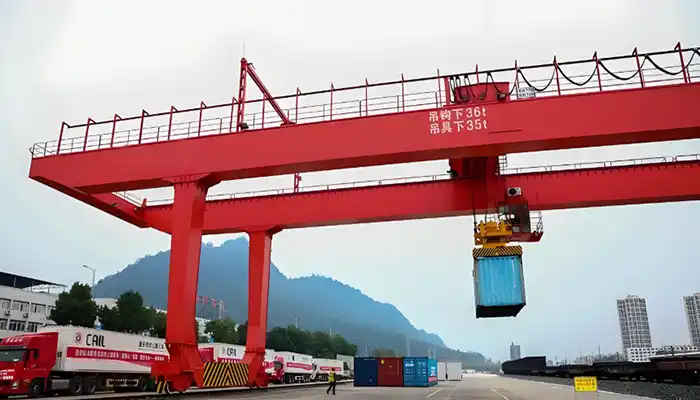
35 ton container handling crane
Economic Considerations
Affordable for Mid-Sized Ports While Maintaining High Productivity:
- For mid-sized ports, the 41-ton crane offers a cost-effective solution that doesn't compromise on performance.
- These cranes allow ports to handle substantial container traffic without the high capital and operational costs associated with larger cranes, making them an attractive option for facilities seeking to maintain productivity while being mindful of budget constraints.
The 41-ton crane is popular because it offers a solid combination of cost efficiency, versatility, and strong performance, making it a reliable choice for many medium-sized terminals.
Specialized Cranes and Their Capacities
Heavy Lift Cranes for Oversized Containers
Typical Capacity:100 tons and above
Applications:
- Heavy lift cranes are specifically designed for handling extremely heavy or oversized cargo that exceeds the capacity of standard container handling equipment.
- These cranes are essential for lifting large machinery, industrial equipment, and other specialized containers that cannot be handled by regular cranes due to their size and weight.
Key Features:
- Massive Lifting Capacity: Heavy lift cranes can handle extremely heavy loads, often exceeding 100 tons, making them suitable for large-scale projects.
- Specialized Rigging Systems: To lift oversized cargo, these cranes are often equipped with custom rigging or spreader bars that can securely hold irregularly shaped or extremely heavy containers.
- Extended Reach: These cranes have long booms and high lifting heights to ensure they can reach across wide ships or large storage areas.
Heavy lift cranes are vital for ports or terminals dealing with specialized and oversized cargo, offering the robust lifting power needed for these heavy-duty tasks.
Hybrid and Energy-Efficient Cranes
Capacity Range:Typically 40 tons to 50 tons
Key Features:
Use of Green Technologies and Energy-Saving Features:
- Hybrid cranes combine electric and diesel power to reduce fuel consumption and emissions. This makes them an eco-friendly choice for operations aiming to reduce their carbon footprint.
- Energy-efficient cranes often incorporate regenerative braking systems and other technologies to optimize energy usage, making them more sustainable and cost-effective over the long term.
Applications:
- Hybrid cranes are becoming increasingly popular in ports and terminals aiming to reduce environmental impact while maintaining high productivity.
- These cranes are commonly used in regions where green initiatives and sustainability goals are a priority.
Hybrid and energy-efficient cranes are a step toward greener port operations, offering a way to reduce energy consumption without sacrificing performance. Their growing popularity is driven by both environmental considerations and the cost savings they offer over time.
Case Studies
Case Study 1: A Major Port's Use of 41-Ton Cranes
Overview of Operations at a Medium-Sized Port:
- This case study explores the operations of a medium-sized port that handles a steady volume of containers. The port serves a variety of vessels, from smaller container ships to some mid-sized ones, and deals with standard 20-foot and 40-foot containers.
- To meet the growing demands of container handling, the port decided to invest in 41-ton cranes, which were ideal for their needs.
Benefits of 41-Ton Cranes in Enhancing Throughput and Reducing Costs:
- The introduction of 41-ton cranes significantly boosted the port's throughput, allowing it to handle more containers per day.
- These cranes provided a cost-effective solution for mid-sized terminals, as they offered the right balance of lifting capacity and operational costs.
- The versatility of the 41-ton cranes allowed the port to efficiently manage both standard and specialized containers, resulting in fewer delays and smoother operations.
Case Study 2: Heavy Lift Cranes in Large Container Terminals
Focus on Ultra-Large Vessels and Specialized Heavy Lifting Operations:
- In large container terminals handling ultra-large container vessels (ULCVs), the demand for heavy lift cranes is critical. This case study looks at how these terminals use 100-ton or greater cranes to manage the handling of oversized and heavy cargo.
- These terminals require cranes with much greater lifting capacity due to the larger container ships and the weight of specialized cargo.
Insights into Crane Capacity Needs for Large-Scale Operations:
- For large-scale operations, heavy lift cranes are essential for lifting extremely heavy containers or equipment, such as oversized machinery and cargo.
- These cranes have specialized features, including longer booms and custom lifting rigs, to manage the complex lifting tasks posed by these larger vessels and containers.
- The use of heavy lift cranes ensures that operations run smoothly without compromising the safety or efficiency of the terminal.
Case Study 3: Straddle Carrier Use in Container Yards
Example of Straddle Carrier Operations in a Busy Terminal:
- Straddle carriers are widely used in container yards to move containers from one location to another. This case study examines how a busy terminal uses straddle carriers to handle container transport in confined yard spaces.
- These carriers are used to stack containers, transport them to trucks for loading, or store them in the yard for future handling.
Benefits of Mobility and Versatility for Container Transport in Confined Spaces:
- Mobility: Straddle carriers offer high mobility, allowing them to navigate tight spaces within the yard, an essential feature for terminals with limited maneuvering room.
- Versatility: They can handle both standard and specialized containers and are particularly useful in terminals where space optimization is crucial.
- Straddle carriers can also reduce congestion in container yards, as they are designed to work efficiently in high-density storage areas. This flexibility allows terminal operators to maximize space while maintaining fast processing times.
These case studies highlight how different cranes and equipment capacities are effectively applied in real-world scenarios, offering insights into their advantages and the challenges of container handling across various terminals.
Conclusion
Typical Crane and Equipment Capacities for Container Handling:
- We've explored the most commonly used cranes in container handling, including Ship-to-Shore (STS) cranes, Rubber-Tired Gantry (RTG) cranes, and Straddle Carriers. Each type has a specific capacity range, from 30 tons to 100 tons or more, depending on the operational needs of the terminal.
- Whether for loading/unloading ships or managing containers in the yard, understanding the capacity and application of each crane type is crucial for smooth terminal operations.
Factors Influencing Crane Selection Based on Terminal Requirements:
- The size of the terminal, the type of cargo (standard, oversized, or hazardous), and the operational environment all play important roles in crane selection. Factors like container size, terminal layout, and even economic considerations are vital in making the right choice.
Advances in Crane Technology:
- The future of container handling lies in advances in technology, with a shift toward automated cranes, hybrid and energy-efficient systems, and smarter control systems.
- The growing demand for larger vessels and the need for cranes with greater capacities are also likely to shape the future. As the shipping industry continues to evolve, so will the technology used in ports and terminals, focusing on improved efficiency, reduced environmental impact, and greater safety.
The Importance of Selecting the Right Crane and Handling Equipment:
- Choosing the appropriate crane for the job is critical for ensuring the operational efficiency and safety of any terminal. The right crane can lead to better productivity, reduced costs, and fewer accidents.
- Understanding the specific needs of your terminal and selecting equipment based on those needs will ultimately maximize throughput and minimize downtime, ensuring a smooth and effective container handling process.
By carefully considering crane capacities and selecting the most appropriate equipment, ports and terminals can stay ahead in an increasingly competitive and demanding industry.
Main Projects
Related Products
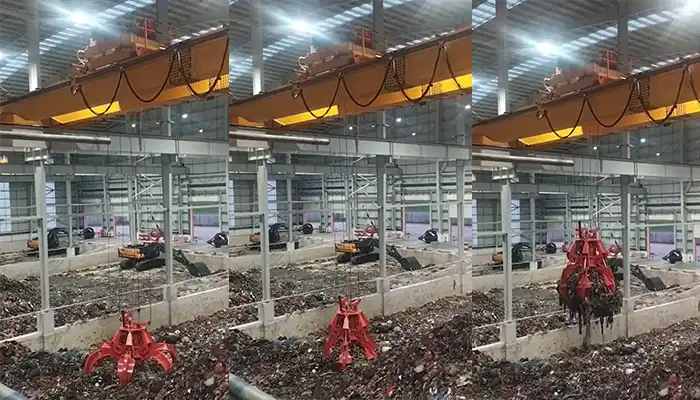
Supplied three grab bucket crane kits to Indonesia, enhancing garbage handling efficiency with high load capacity and reliable performance.
Free consultation to Confirm Parameters & Specifications and Get
Latest Crane Price & Crane Rate.
- Types of overhead cranes : _______?
- Optional: Overhead travelling crane, goliath gantry crane,Slewing jib crane, Single girder or double girder crane,small portable crane or kbk crane, etc.
- Capacity of overhead crane: _______?
- Optional: 0.25ton, 0.5 ton, 1 ton, 2 ton, 3ton, 5 ton, 10 ton,15ton, 20ton, 25 ton, 30ton,35ton, up to 550ton, etc.
- Crane span & lifting height : _______?
- Crane travelling length : _____?
- Control of overhead crane:_______?
- Optional: pendant/ remote/cabin control
- Voltage supply of overhead crane:_____?
- Eg,: 380V50/60HZ,3Phase or others,etc.
- Application/usage of crane:_______?
- Eg,: Steel mill, ,injection mold, cement,stone, concrete,granite, general manufacturing, etc.
Just leave a message via the contact form and our hoist and crane engineer will contact you with in 24working hours.
Get In Touch
